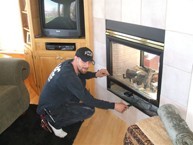Originally based on a series of children’s books written by P. L. Travers, the popular Walt Disney film Mary Poppins instilled in the American imagination a delightful portrait of the chimney sweep, played by Dick van Dyke, who sings and dances well, even when covered in soot. We might call this the romantic image of the late 19th and early 20th century English chimney sweep who performs difficult labor with a smile on his face.
Of course, as with many of our modern professions, the history of chimney sweeping was not always as pleasant as the Plymouth, MN chimney sweeping experts at 2nd Generation Chimneys make it! The occupation had its hardships, including illness and disease from soot and carbon monoxide.
In this post, we’d like to give you an overview of the profession of chimney sweeping. For Plymouth, MN chimney sweeping, call the experts at 2nd Generation Chimneys today!
Long used in ancient Rome, chimneys became especially prevalent in post-Renaissance Europe, especially for nobility, whose castles and palaces were well equipped with numerous fireplaces, many of them quite extravagant. But even for the average row house, the use of wood as a fuel to both heat and cook meant that the home fireplace received much more use than they do today. When creosote builds up, it becomes a fire hazard and blocks the ventilation. Up until the late 18th century, both the English and Americans alike were largely ignorant of the dangers of soot, creosote, and carbon monoxide, so that young apprentices would often be susceptible to disease early in life. Such conditions were stemmed by governmental restrictions, but it wasn’t until the 20th century that such dangers were truly exposed.
The modern chimney sweep uses much of the same equipment as his predecessors to remove creosote and soot buildup from the interior surface of chimneys: brushes and scrapers. But, vacuum technology has made the practice much safer to perform, and safety equipment is regularly used to prevent inhalation of noxious particles. A clean chimney allows you to heat your home confidently. It provides excellent comfort throughout the heating season.
When you need chimney services, make sure you contact a professional. For more information, or to schedule a Plymouth, MN chimney sweeping, call the experts at 2nd Generation Chimneys today!

